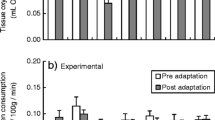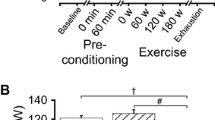Abstract
To investigate the effects of cooling on local temperature and circulation in the skin and skeletal muscle at different cooling temperatures. Ten male subjects (mean age 24.9 years) participated in this study. Intramuscular temperatures were measured by inserting two 22-gauge temperature probes (needle length; 8 and 18 mm) into the ankle dorsiflexors, while skin temperature was measured using a thermocouple attached to the leg skin anteriorly. Near-infrared spectroscopy was also used to evaluate the concentration changes in oxygenated, deoxygenated, and total hemoglobin/myoglobin in local skin and skeletal muscle. These measurements were simultaneously performed during the 10-min noncooling, 30-min cooling (cooling pad temperature; 0, 10, or 20°C), and 60-min recovery periods. Under all cooling conditions, skin and intramuscular temperatures decreased during cooling (P < 0.01) and began to increase after the cooling pad was removed. However, these values did not return to baseline values during the recovery period (P < 0.01). Moreover, tissue temperatures tended to show lower values during cooling at lower cooling temperatures. All hemoglobin/myoglobin concentrations also showed a concomitant significant decrease during cooling under three cooling conditions (P < 0.01); the oxygenated and total hemoglobin/myoglobin concentrations did not return to the exact values before cooling during the recovery period. This study suggested that the rate of decrease in tissue temperature depends on the cooling temperature and the effects of cooling on tissue temperatures and circulation tend to be maintained during 60 min post-cooling period despite the cooling temperature.





Similar content being viewed by others
References
Bleakley C, McDonough S, MacAuley D (2004) The use of ice in the treatment of acute soft-tissue injury: a systematic review of randomized controlled trials. Am J Sports Med 32:251–261
Chance B, Dait MT, Zhang C, Hamaoka T, Hagerman F (1992) Recovery from exercise-induced desaturation in the quadriceps muscles of elite competitive rowers. Am J Physiol 262(Cell Physiol. 31):C766–C775
Curl WW, Smith BP, Marr A, Rosencrance E, Holden M, Smith TL (1997) The effect of contusion and cryotherapy on skeletal muscle microcirculation. J Sports Med Phys Fitness 37:279–286
Daanen HA, Van de Linde FJ, Romet TT, Ducharme MB (1997) The effect of body temperature on the hunting response of the middle finger skin temperature. Eur J Appl Physiol 76:538–543
DeLorey DS, Shaw CN, Shoemaker JK, Kowalchuk JM, Paterson DH (2004) The effect of hypoxia on pulmonary O2 uptake, leg blood flow and muscle deoxygenation during single-leg knee-extension exercise. Exp Physiol 89:293–302
Dolan MG, Thornton RM, Fish DR, Mendel FC (1997) Effects of cold water immersion on edema formation after blunt injury to the hind limbs of rats. J Athl Train 32:233–237
Elwell CE (1995) A practical users guide to near infrared spectroscopy. Hamamatsu Photonics KK, London, pp 1–155
Enwemeka CS, Allen C, Avila P, Bina J, Konrade J, Munns S (2002) Soft tissue thermodynamics before, during, and after cold pack therapy. Med Sci Sports Exerc 34:45–50
Fox RH, Wyatt HT (1962) Cold-induced vasodilatation in various areas of the body surface of man. J Physiol (Lond) 162:289–297
Hamaoka T, Iwane H, Shimomitsu T, Katsumura T, Murase N, Nishio S, Osada T, Kurosawa Y, Chance B (1996) Noninvasive measures of oxidative metabolism on working human muscles by near-infrared spectroscopy. J Appl Physiol 81:1410–1417
Hurme T, Rantanen J, Kalimo H (1993) Effects of early cryotherapy in experimental skeletal muscle injury. Scand Med Sci Sports 3:46–51
Jutte LS, Merrick MA, Ingersoll CD, Edwards JE (2001) The relationship between intramuscular temperature, skin temperature, and adipose thickness during cryotherapy and rewarming. Arch Phys Med Rehabil 82:845–850
Kanlayanaphotporn R, Janwantanakul P (2005) Comparison of skin surface temperature during the application of various cryotherapy modalities. Arch Phys Med Rehabil 86:1411–1415
Merrick MA, Rankin JM, Andres FA, Hinman CL (1999) A preliminary examination of cryotherapy and secondary injury in skeletal muscle. Med Sci Sports Exerc 31:1516–1521
Merrick MA, Knight KL, Ingersoll CD, Potteiger JA (1993) The effects of ice and compression wraps on intramuscular temperatures at various depths. J Athl Train 28:236–245
Myrer JW, Measom G, Fellingham GW (1998) Temperature changes in the human leg during and after two methods of cryotherapy. J Athl Train 33:25–29
Myrer JW, Myrer KA, Measom GJ, Fellingham GW, Evers SL (2001) Muscle temperature is affected by overlying adipose when cryotherapy is administered. J Athl Train 36:32–36
Quaresima V, Lepanto R, Ferrari M (2003) The use of near infrared spectroscopy in sports medicine. J Sports Med Phys Fitness 43:1–13
Sendowski I, Savourey G, Launay JC, Besnard Y, Cottet-Emard JM, Pequignot JM, Bittel J (2000) Sympathetic stimulation induced by hand cooling alters cold-induced vasodilatation in humans. Eur J Appl Physiol 81:303–309
Shepherd JT, Rusch NJ, Vanhoutte PM (1983) Effect of cold on the blood vessel wall. Gen Pharmacol 14:61–64
Swenson C, Swärd L, Karlsson J (1996) Cryotherapy in sports medicine. Scand J Med Sci Sports 6:193–200
Taber C, Contryman K, Fahrenbruch J, LaCount K, Cornwall MW (1992) Measurement of reactive vasodilation during cold gel pack application to nontraumatized ankles. Phys Ther 72:294–299
Thorlacius H, Vollmar B, Westermann S, Torkvist L, Menger MD (1998) Effects of local cooling on microvascular hemodynamics and leukocyte adhesion in the striated muscle of hamsters. J Trauma 45:715–719
Thorsson O, Lilja B, Ahlgren L, Hemdal B, Westlin N (1985) The effect of local cold application on intramuscular blood flow at rest and after running. Med Sci Sports Exerc 17:710–713
Van der Zee P, Cope M, Arridge SR, Essenpreis M, Potter LA, Edwards AD, Wyatt JS, McCormick DC, Roth SC, Reynolds EO, Delpy DT (1992) Experimentally measured optical pathlengths for the adult head, calf and forearm and the head of the newborn infant as a function of inter optode spacing. Adv Exp Med Biol 316:143–153
Yanagisawa O, Kudo H, Takahashi N, Yoshioka H (2004) Magnetic resonance imaging evaluation of cooling on blood flow and oedema in skeletal muscles after exercise. Eur J Appl Physiol 91:737–740
Zemke JE, Andersen JC, Guion WK, McMillan J, Joyner AB (1998) Intramuscular temperature responses in the human leg to two forms of cryotherapy: ice massage and ice bag. J Orthop Sports Phys Ther 27:301–307
Acknowledgments
The authors would like to thank the researchers and the medical staff of the Japan Institute of Sports Sciences for their helpful comments and assistance. They are grateful for the Grant-in-Aid for Scientific Research (Grant-in-Aid for Young Scientists) provided by the Ministry of Education, Culture, Sports, Science and Technology to support this study. The authors also thank all subjects who participated in this study.
Author information
Authors and Affiliations
Corresponding author
Rights and permissions
About this article
Cite this article
Yanagisawa, O., Homma, T., Okuwaki, T. et al. Effects of cooling on human skin and skeletal muscle. Eur J Appl Physiol 100, 737–745 (2007). https://doi.org/10.1007/s00421-007-0470-3
Accepted:
Published:
Issue Date:
DOI: https://doi.org/10.1007/s00421-007-0470-3




